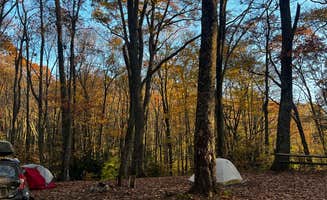Hidden Valley Wildlife Management Area remains the primary dispersed camping destination near Dryden, Virginia. Situated among the Appalachian foothills at approximately 2,200 feet elevation, this area experiences significant seasonal variation with summer temperatures typically 10-15 degrees cooler than surrounding lowlands. The remote location creates opportunities for wildlife viewing while camping in a rustic setting.
What to do
Fishing opportunities: The lake at Hidden Valley WMA offers excellent fishing conditions. "The lake is calm and clean for water recreation," notes one visitor who appreciated the water quality.
Hiking trails: Several unmarked but established paths wind through the fern-dominated forest surrounding the camping areas. Visitors can explore the dense undergrowth while staying within the wildlife management boundaries.
Wildlife observation: The management area's primary purpose is wildlife conservation, making it ideal for birdwatching and animal spotting. Early mornings provide the best viewing opportunities for deer and various bird species native to Virginia's mountain regions.
What campers like
Solitude and quiet: Many visitors appreciate the isolation this area provides. "We had the place to ourselves which was really great," reports one camper who enjoyed the private atmosphere during their stay.
Basic facilities: Unlike many dispersed camping areas, Hidden Valley offers minimal but appreciated amenities. "Porta Jon available at campground and boat dock. Plenty of dead wood for fires. Trash cans available," mentions a camper who valued these basic conveniences.
Affordability: The low-cost permit system makes this an economical rustic camping option. "Camping is free, technically. You need to purchase an Access pass from Virginia Wildlife for 4 dollars online, and add a camping authorization to your account," explains one visitor who navigated the permit system.
What you should know
Road conditions: The access road presents significant challenges for some vehicles. "The road up is a pretty harsh grade for 4 miles. Our short bus Skoolie had some troubles with it," warns a camper who experienced difficulty with the steep terrain.
Permit requirements: All campers must obtain proper permits before arrival. Virginia Wildlife Access Permits are required in addition to camping authorization, which must be secured online prior to your visit.
Limited campsites: The area contains approximately 4-5 established vehicle spots and a small number of tent sites. During peak seasons (spring and fall), arriving early is recommended to secure a spot.
Night activity: Some visitors have noted unusual traffic patterns after dark. "There also are a few peculiar characters that come in and out of the parking lot at night," cautions one camper regarding the occasional nighttime visitors.
Tips for camping with families
Bear precautions: The area provides bear bins for food storage. Instruct children about proper food handling and storage techniques before arrival, as black bears are native to the region.
Water safety: While the lake provides recreational opportunities, no lifeguards monitor swimming areas. Children should be supervised at all times near water.
Activity planning: The remote location means no nearby facilities or entertainment options. Bring games, field guides, and activities appropriate for the forest environment to keep children engaged.
Tips from RVers
Vehicle specifications: Large RVs and trailers may struggle with access. The steep grades on the entrance road require vehicles with sufficient power and good brakes. Smaller camper vans and truck campers are better suited to the conditions.
Site selection: The approximately four pull-in spots vary in size and levelness. Early arrival allows selection of the most suitable location for your specific vehicle configuration.
Self-sufficiency: No hookups or dumping facilities exist at this location. RVers must be prepared for fully off-grid camping with appropriate water storage and waste management systems.


